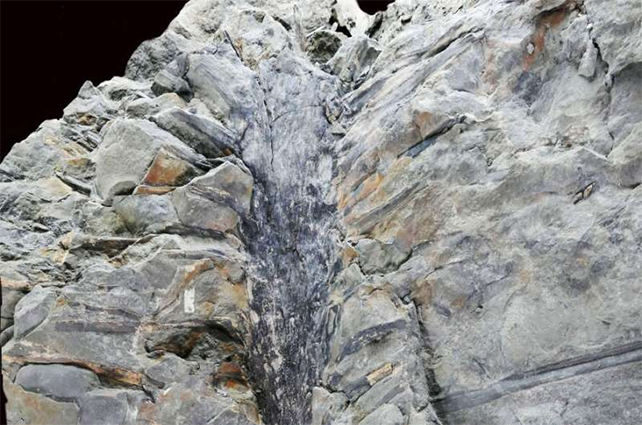It’s hard to imagine the Earth without its forests. However, it wasn’t until the Devonian period, just 400 million years ago, that the first tree awkwardly appeared. Our knowledge of ancient tree development mostly comes from stumps and roots preserved in rock, with the occasional flattened leaves and branches between layers of mud and stone. A 2.3-meter (7.5-foot) long and roughly 2-meter-wide stone block at Canada’s New Brunswick Museum provides researchers with a three-dimensional view of an ancient species that sprouted around 15 million years after the first tree-like flora appeared. This remarkable block, preserved in 2017 by New Brunswick Museum paleontologists Olivia King and Matthew Stimson, reveals the remains of five branching plants growing closely together, displaying the arrangements of their top leaves in great detail.
The way in which this tree produced extremely long leaves around its thin trunk, and the sheer number of leaves over a short length of trunk, is surprising,” says Robert Gastaldo, a geologist from Colby College in the US who led an investigation into the remarkable fossil. Though palm trees wouldn’t appear for another few hundred million years, the extended, radiating leaves of the plant currently classified as Sanfordiacaulis densifolia have a resemblance to something you’d find in a desert or a tropical island.
As the Devonian transitioned into the Carboniferous period, plants like conifers, cycads, and Ginkgo emerged and multiplied. Understanding the period’s more enigmatic plants based on limited details is more challenging. The fossil under investigation is unique and represents a strange growth form in the history of life. It is one of evolution’s experiments during a time when forest plants underwent biodiversification, and it is a form that seems to be short-lived.
It is thought that the small grove, presumably growing by the side of a lake in earthquake-prone territory, was smothered due to a tremor that buried the plants and other nearby vegetation in fine mud. The researchers estimate that its height could reach nearly 3 meters, if not higher, with a thick arrangement of leaves extending 2 to 3 meters from the trunk to form a dense volume of foliage at the crown of up to 30 square meters. Like many similar trees competing for light beneath thick forest canopies, Sanfordiacaulis may have evolved its bottle-brush anatomy to capture as much radiation as possible while being overshadowed by larger flora.
Such pristine examples of long-extinct vegetation developing as ecosystems tested new environments and conditions for survival provide researchers with a clearer picture of the trial-and-error approach that evolution takes. Rare and unusual fossils, such as the New Brunswick tree, are examples of what colonized our planet but were unsuccessful experiments. This research is published in Current Biology.










